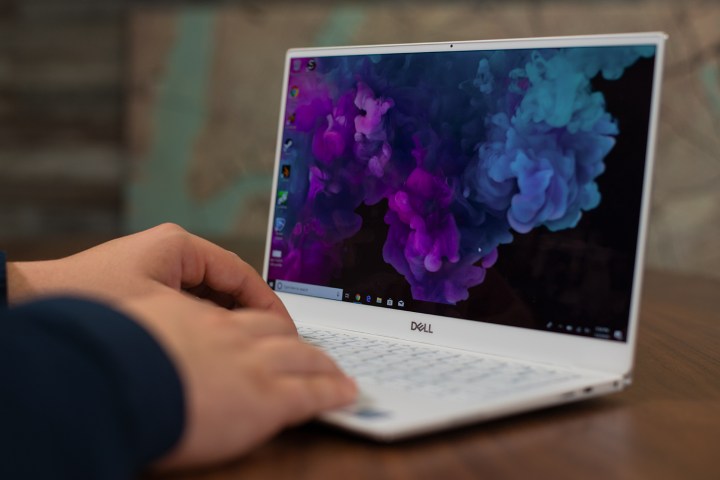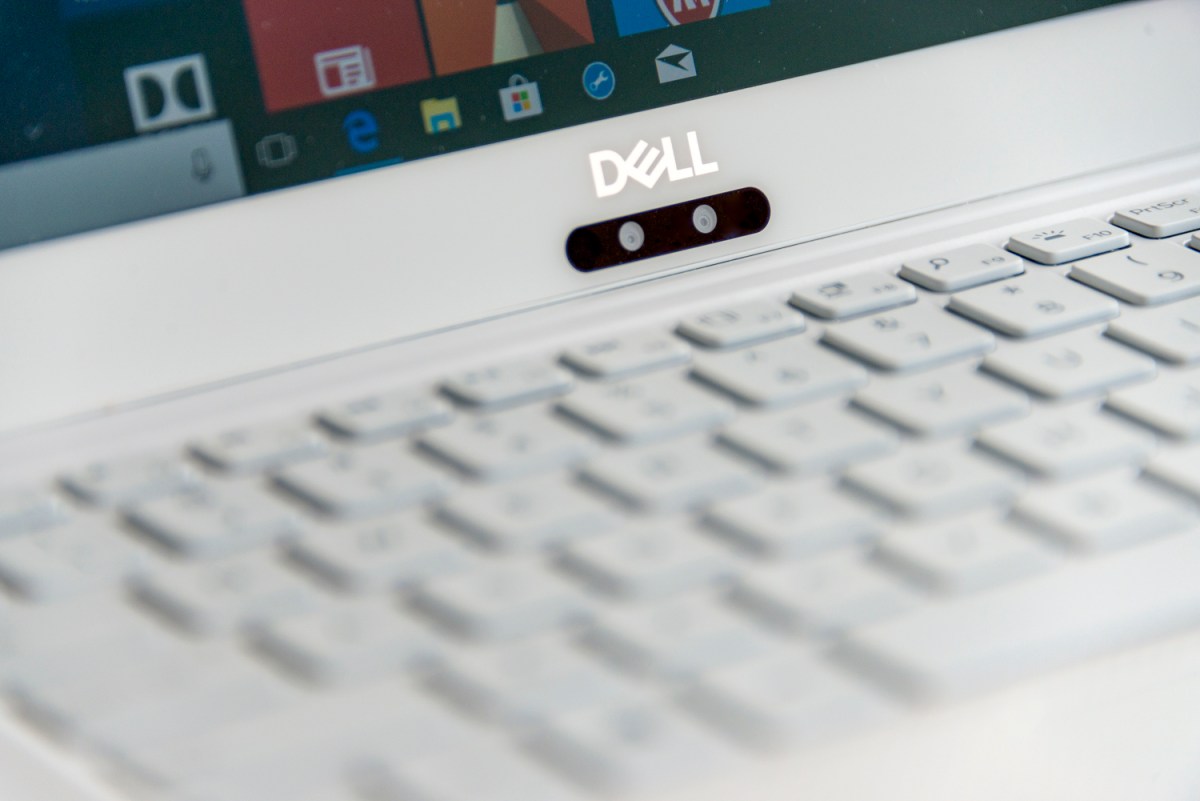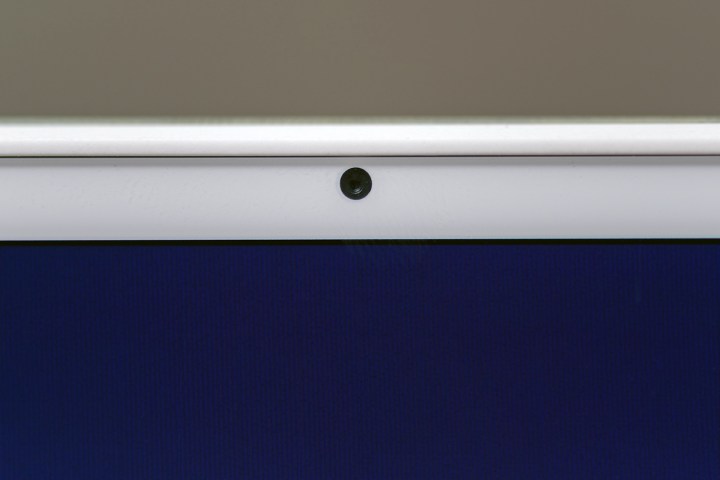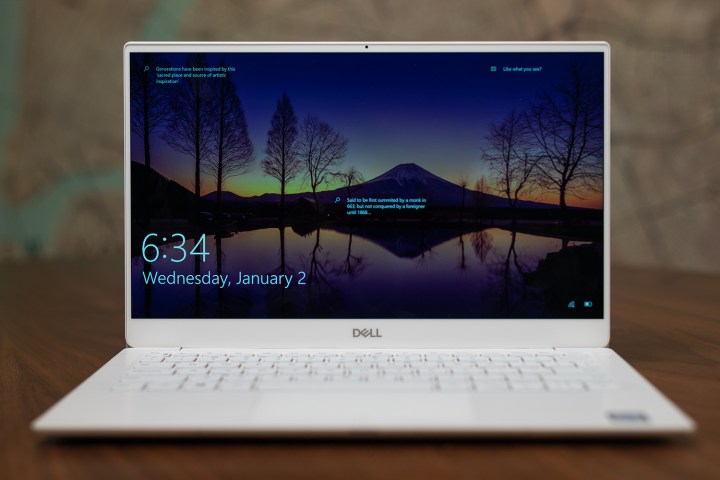Is Dell Xps 13 ' Web Camera At Bottom?

We love thin-bezel displays. The thinner, the better. All the same there is one issue that has plagued this otherwise crawly blueprint innovation.
The webcam.
Dell, the pioneer of thin-bezel laptops, opted to place the webcam below the brandish. The result was an unflattering "olfactory organ-cam" that felt similar a hold-over for a existent fix to the problem. The latest version of the XPS xiii finally introduces that ready. The engineers and technologists at Dell have shrunken camera to get in fit in a miniscule bezel.
Doing it required years of piece of work and forced Dell to consider many solutions, including a smartphone-similar notch.
The legacy of the nose-cam
The olfactory organ-cam of the XPS 13 was its Achilles heel. It was the butt of jokes by other manufacturers and PC enthusiasts alike.
"We've had a lot of great feedback. We've also had a lot of pointed feedback, which is skilful likewise," Randall Heaton politely told u.s.a.. He'due south been the Product Manager for the XPS clamshells at Dell since before the InfinityEdge bezels were first introduced. "That way we know what to work on. I volition admit that I didn't realize I had a double chin until that camera location. And then, I kind of sympathise the feedback."

Dell took the criticism well because it knew a ready was required. Placing the camera below the screen, pointed up your nostrils, was never a permanent solution. Still, Dell doesn't regret making the compromise.
"We always knew we'd have to solve it," said Heaton. "When we went to the InfinityEdge, at that place was a lot of doubt internally whether that was the right decision. Patently, thin bezels seemed similar the smart affair to practise. Moving the photographic camera to the lesser? That did non seem like a smart thing to do. I remember there was more angst for united states of america ourselves. Is everyone else going to remember that this is the right trade-off we made hither?"
Thin bezels seemed similar the smart affair to practise. Moving the photographic camera to the bottom? That did not seem like a smart matter to do.
Given how the sparse-bezel trend has taken off, the respond seems articulate. In that location's not a single laptop manufacturer today that doesn't iterate on narrow bezels in some way. Fifty-fifty Apple has trimmed downward its MacBook bezels in response to the pressure of increasingly sparse frames.
"When we made the decision, we thought that was a problem we'll solve with the side by side iteration. What nosotros didn't realize quite how much of a challenge it would exist for our engineering teams and technologists to actually create a solution […]"
The difficulty of the situation became articulate as Dell'south engineered began piece of work on the start XPS 13'due south successor. No unmarried camera component was the issue. Every component was an outcome. The sensor was besides big, the lens was too big, the circuit boards were too big, and even more hardware was needed to wire it all together. Squeezing a photographic camera dorsum in the summit bezel wasn't a thing of rearranging parts. It meant engineering new parts and packaging them in new ways.
That's why shrinking the camera wasn't the get-go option — and nosotros should all be glad Dell didn't choose of the alternatives that were considered.
The notch that never was
Cutting out a notch in the brandish seems the obvious solution at starting time blush. The iPhone did information technology first, and merely almost every smartphone manufacturer has followed suit. It's just a thing of time earlier they came to laptops, right?
"There were lots of other ideas floating around," Maxwell Andrews, a managing engineer at Dell, told u.s.a.. "Nosotros really considered [a notch] quite a bit before the telephone market was implementing this."
More Dell XPS 13 coverage
- Review: The Dell XPS 13 was already the best laptop. Now information technology'southward most perfect.
- Huawei's Matebook xiii is shockingly skillful, but tin it challenge the Dell XPS 13?
- two-in-1s fade equally premium laptops fight the battle of the bezels
- Everything new with the 2019 Dell XPS thirteen
If that makes you nervous, you're non alone. Placing a notch in a Windows laptop isn't quite like doing it on an iPhone. The outset of the many problems was in the user experience itself.
"We did some mockups," said Andrews. "To have this beautiful, undisturbed canvas and and so to have some intrusion into that is pretty glaring. We didn't desire to impact people's display experience for a camera feature that most merely use occasionally. The display is something that customers uses every unmarried mean solar day. Information technology'south the flagship feature of the product. Information technology's where all the information, all the work, all the content — it comes through that brandish."
Andrews is right. Taking a selfie on a smartphone is a chip more mutual than taking one on a PC. And making room for a notch on Instagram or WhatsApp is one thing. Only in Photoshop or Google Chrome or CAD? That'due south different. A notch could easily obscure important toolbars that users need to access.
Windows likewise doesn't let the aforementioned degree of customization that iOS or Android does. Apple tree completely controls iOS, while Google maintains very petty command over Android. Microsoft, yet, has an opinion about the baseline experience every Windows users should have, and while Dell is one of the larger PC manufacturers, even it doesn't have enough sway ask for an entirely new Windows feature that benefits only one laptop.
That was that. The notch was out. But it wasn't the only choice on the table. This is where things get weird.
One concept put the photographic camera behind the screen, which would have solved the problem entirely. This, similar the notch, is not an entirely new concept. Various companies have pursued the thought in different ways, though with niggling success. Dell was no exception. The company couldn't source the OLED panel information technology needed, and early on engineering tests didn't produce groovy results.

"There's a lot of artifacts that are created because y'all're essentially still shooting through a grid of wires, so the paradigm quality is awful. Even if nosotros had an OLED panel to piece of work with, that just wasn't meeting the quality requirements."
Another solution involved killing a couple of pixels in the center of the screen and setting the camera backside it. That, withal, had an obvious problem – dead pixels in the center of the screen.
Desperate, Dell's engineers were forced to consider unusual solutions. The strangest was a periscope camera. Andrews described a camera that folded into an "L" shape, bending at a 90-caste angle so the sensor could line up with the lens. Information technology was an intriguing idea that helped go on the bezel small-scale, but information technology resulted in its ain protrusions from the chassis.
Ultimately, Dell had to come up back to the obvious yet difficult ready. The camera had to exist smaller. With the goal obvious, the company's engineers went to work, though they had no thought if success was possible.
A sliver here, a sliver there
About components that make upwardly a webcam placed in your calculator are made by unlike companies. The sensor, the lens, the structure around the lens — even the procedure of putting it altogether. Much of that is exterior Dell'due south sphere of influence.
"Nosotros had to do a lot of deep investigations with our suppliers to see what we could make progress on," Andrews told united states. "Ultimately, nosotros saw a path where if we could get the smaller lens, some optimizations from our sensor supplier, and a improve way to package those two components together that removes some of the unnecessary mechanical pieces of the camera, we could get to something very, very minor."

It started with the sensor. This central component is a article role meant to be sold as a standard piece to many vendors. Convincing a vendor to brand a small custom sensor for Dell wasn't almost to happen. Dell might be ane of the largest PC manufacturers, just compared to the kinds of numbers smartphone companies push, information technology doesn't have much sway.
Instead, the company had to do something far more challenging. It had to convince its partners it was on to something big. Something bigger than only Dell.
"At the time, I don't think they had equally much involvement in solving the problem because we were the only ones doing a sparse bezel," Randall Heaton told u.s.a.. "But at present that more and more notebooks are coming out with thinner bezels, the manufacturer idea, 'Okay, it makes sense for me to develop a new manufacturing process for this and do it in an efficient manner.'"
The company had to convince its partners it was on to something large.
Dell started that thin bezel tendency, and ultimately, its vendor partner saw the do good. Dell was one of the first buyers, snatching the sensors up hot off the assembly line.
With the smaller sensor in hand, Dell needed a smaller lens and plastic housing to put it all together. This, too, was harder than you might recollect. Building the new camera wasn't just a matter of asking the visitor assembling it to spiral the parts together more than tightly. Entirely different techniques were needed to shave off the last few millimeters.
"Since they're actually assembling the camera, we work with them to bring some of the really advanced assembly machinery from their prison cell phone photographic camera product line over to the PC side, which is something they hadn't done before," said Andrews. "Nosotros really pushed them to modernize their PC camera associates so that we could achieve this extremely small package."
How advanced? Well, information technology involves robots and lasers. The threading that normally holds the lens direct in line with the sensor was function of the vertical stack that didn't fit in the bezel. And then, information technology was removed. At present the lens is placed by a robot to ensure a perfect alignment, and and then glued in place. The excess glue is and then trimmed off with a laser. These are techniques used for smartphone cameras, but it's new territory for PCs.

Shrinking each piece and and so cutting out every sliver of a millimeter of vertical meridian from the assembly, Dell finally transformed a 7mm camera into a ii.25mm camera. That'southward but minor enough to be squeezed into what Dell calls an "InfinityEdge" screen.
But with a smaller sensor and lens came a different problem. Image quality. A sensor that pocket-sized isn't exposed to enough calorie-free to create a loftier-quality prototype and trying to add more than light can atomic number 82 to excess noise that muddies the image. Dell calls its ain proprietary solution to the problem "temporal noise reduction." It'south a applied science that had been in the works for years, but in the new XPS 13 camera, it's plant its platonic match.
"This temporal noise reduction takes multiple frames of the moving picture and compares information technology, and then is able to get rid of some of the dissonance that might be introduced by the smaller sensor with less light getting to the camera."
Information technology's a combination of cutting-edge software and hardware — which is exactly where the best pieces of applied science always land.
The result is not an amazing photographic camera experience. It'southward no meliorate than any other laptop's webcam. Simply that was never the goal. Information technology gets the job washed without existence pointed up your nose or increasing the bezels. That'due south a four-year engineering story, finally making its mode into a product you tin can pick up and hold in yours easily.
The journeying continues
Mission accomplished?
Non quite. The designers and engineers at Dell accept a atypical vision of tomorrows laptop. Thinner bezels. Smaller footprint. A maximized screen. Only getting there is going to involve just as much creative thinking equally did the journeying so far.

Every millimeter of the keyboard must be considered. The palmrests. The hinge. The placement of the keyboard. Every attribute must conform to the vision.
"We've got what we think are exciting designs effectually that in the future," says Heaton. "But that's still in the future. To some degree, it's going to exist kind of like this camera location. We haven't solved everything in order to enable what we call up is the perfect system within these limits. Just we're working on how many we can solve one at a fourth dimension."
Editors' Recommendations
- Framework Laptop now offering CPU upgrade to Intel's latest
- New HP Spectre x360 16 ditches Nvidia, embraces Intel Arc
- Acer's new workstations are more powerful than always earlier
- ROG Flow X16 already looks like contender for best new gaming laptop
- Asus Zenbook Pro 16X hands-on review: Fast, feature-packed
Source: https://www.digitaltrends.com/computing/how-dell-fixed-xps-13-biggest-flaw-ces-2019/
Posted by: fernandezheratat.blogspot.com

0 Response to "Is Dell Xps 13 ' Web Camera At Bottom?"
Post a Comment